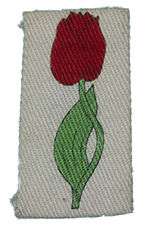204th Independent Infantry Brigade (Home)
204th Independent Infantry Brigade (Home) was a Home Defence formation of the British Army during World War II.
| 204th Independent Infantry Brigade (Home) 204th Independent Infantry Brigade | |
|---|---|
 Insignia of the 204th Independent Infantry Brigade[1] | |
| Active | 12 October 1940-1 September 1942 |
| Country | |
| Branch | |
| Type | Infantry Brigade |
| Role | Home Defence |
| Insignia | |
| Badge worn when in the Lincolnshire County Division |  |
Origin
The 204th Independent Infantry Brigade (Home) was formed for service in the United Kingdom on 12 October 1940 by No 4 Infantry Training Group in the West Midland Area of Home Forces.[2] It was commanded by Brigadier G. McI. Bruce and comprised four newly raised infantry battalions from the North and Midlands of England.[2]
Service
The brigade moved from West Midlands Area to the Lincolnshire County Division when that was formed on 27 March 1941.[2][3] The Lincolnshire County Division ceased to function on 24 November and the brigade, now re-designated the 204th Independent Infantry Brigade was transferred to the Durham and North Riding Coastal Area.[2][3] On 1 September 1942, the Brigade headquarters was re-designated 185th Infantry Brigade and its units transferred to other formations.[2][4] 7th South Lancashires, 12th Foresters and 7th Leicesters went to India[5] while 8th South Lancashires was disbanded.[6]
Order of battle
The composition of the 204th Brigade was as follows:[2]
- 7th Battalion, South Lancashire Regiment (from 12 October 1940 — 31 August 1942)
- 8th Battalion, South Lancashire Regiment (12 October 1940 — 31 May 1941)
- 12th Battalion, Sherwood Foresters (from 12 October 1940 — 31 August 1942)
- 6th Battalion, King's Shropshire Light Infantry (12 October 1940 — 24 November 1941) – converted in March 1943 to the 181st Field Regiment, Royal Artillery[7][8]
- 7th Battalion, Leicestershire Regiment (26 November 1941 — 31 August 1942)
Attached when an Independent Brigade.
- 204th Independent Infantry Brigade Company Royal Army Service Corps (31 March 1942 — 31 August 1942)
Insignia
The brigade's cloth shoulder badge was a triangle composed of three smaller conjoined triangles in the Facing colours of its three senior units: buff (S. Lancashires), pearl grey (Leicesters) and Lincoln green (Foresters), the whole being edged in blue (KSLI).[9]
Notes
- Cole p. 131
- Joslen, p. 367.
- Joslen, p. 113.
- Joslen, p. 360.
- Joslen, pp. 253–4, 292, 538, 543–4.
- S Lancs at Regiments.org
- Neal.
- 181 Fd Rgt at RA 39–45 Archived 2016-03-03 at the Wayback Machine
- Neal, pp. 3 & 30, Plate XLVII.
References
- Cole, Howard (1973). Formation Badges of World War 2 Britain, Commonwealth and Empire. London: Arms and Armour Press.
- Lt-Col H.F. Joslen, Orders of Battle, United Kingdom and Colonial Formations and Units in the Second World War, 1939–1945, London: HM Stationery Office, 1960/Uckfield: Naval & Military, 2003, ISBN 1843424746.
- Don Neal, Guns and Bugles: The Story of the 6th Bn KSLI – 181st Field Regiment RA 1940–1946, Studley: Brewin, 2001, ISBN 1-85858-192-3.